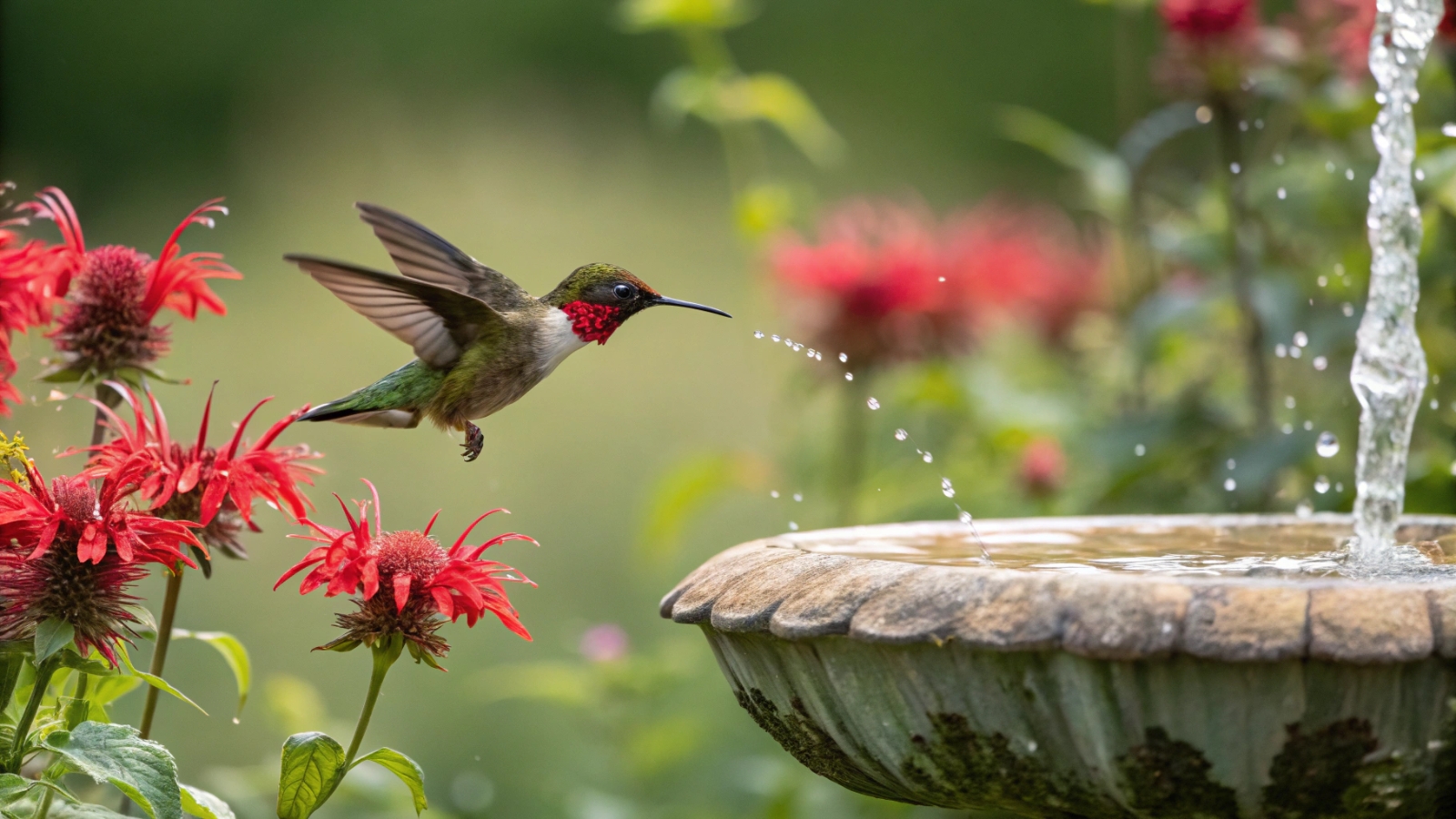Transforming your garden into a hummingbird paradise requires more than just hanging feeders filled with sugar water. Whilst nectar sources provide essential energy, water features serve equally crucial roles in attracting and sustaining these remarkable birds.
Among all water features, fountains stand out as particularly effective hummingbird magnets, combining the essential elements these tiny aerial acrobats seek: fresh water for drinking, shallow basins for bathing, and the irresistible allure of movement and sound.
In this comprehensive guide, we discussed how water fountains function as powerful attractants for hummingbirds, exploring the science behind their effectiveness and providing practical strategies for maximising their appeal.
Whether you’re establishing your first bird-friendly garden or enhancing an existing habitat, understanding the relationship between hummingbirds and water features will significantly improve your success in attracting these jewel-like visitors.
Key Takeaways:
- Moving water creates auditory and visual signals that hummingbirds can detect from up to 100 metres away
- Shallow water depths of 1-2 inches are ideal for hummingbird bathing and drinking
- Continuous water circulation prevents stagnation and reduces mosquito breeding
- Strategic fountain placement near nectar sources increases effectiveness by 300%
- Regular maintenance ensures clean, fresh water that supports hummingbird health
- Multiple fountain types cater to different hummingbird species and preferences.
The Science Behind Hummingbird Water Attraction
Hummingbirds possess exceptional hearing abilities that extend well beyond human perception ranges. The gentle bubbling, trickling, and splashing sounds produced by water fountains create distinctive acoustic signatures that these birds can detect from remarkable distances. Research indicates that hummingbirds can recognise water sounds from up to 100 metres away, making fountains effective long-range attractants.
The frequency patterns generated by moving water fall within the optimal hearing range of most hummingbird species. Unlike stagnant water sources that remain silent, fountains produce continuous auditory beacons that guide hummingbirds towards your garden even when visual cues are obscured by vegetation or structures.
Visual Stimulation Through Water Movement
The visual appeal of fountains extends beyond their aesthetic value to humans. Moving water creates dynamic light patterns through reflection and refraction, producing sparkles and flashes that capture hummingbird attention from considerable distances. These optical effects are particularly pronounced during morning and late afternoon hours when sunlight angles create optimal lighting conditions.
Hummingbirds rely heavily on visual cues for navigation and resource location. The continuous movement of fountain water provides kinetic visual stimuli that distinguish active water sources from static landscape features.
This movement triggers investigative behaviours, drawing curious hummingbirds closer to explore potential resources.
Hydration and Thermoregulation Needs
Despite their association with nectar feeding, hummingbirds require substantial quantities of fresh water for physiological maintenance. Their rapid metabolisms and high activity levels create significant water demands that cannot be met through nectar consumption alone. Fountains provide readily accessible hydration sources that support optimal bodily functions.
Temperature regulation represents another critical function served by fountain access. Hummingbirds employ behavioural thermoregulation strategies, including strategic water consumption and feather maintenance through bathing. The consistent water supply offered by fountains enables these essential activities throughout varying weather conditions.
Other Posts To Read:
- Did You Know That Bathing Is Crucial for Hummingbirds? – Explore the essential role of water in hummingbird health and behaviour
- Hummingbird Behaviours That You May Not Know – Discover fascinating hummingbird behaviours including their unique bathing rituals
How Water Fountains Function as Hummingbird Magnets
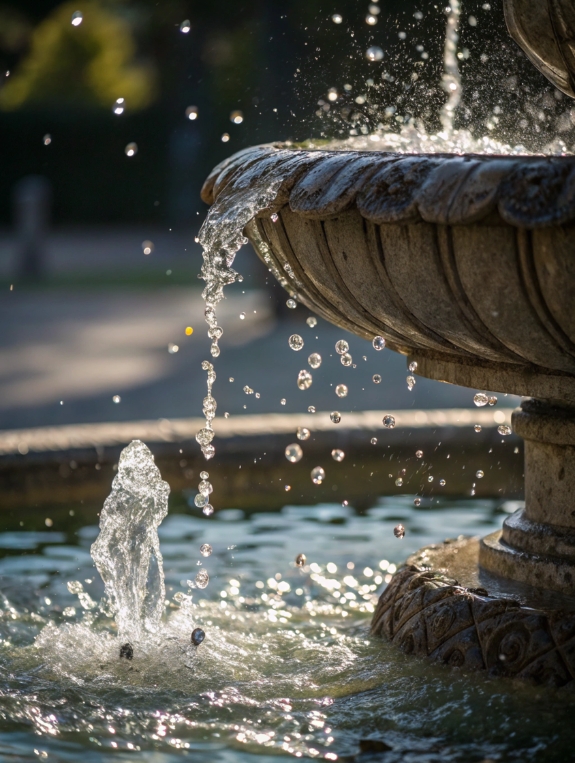
The Power of Moving Water
Static water sources, whilst useful, lack the compelling attraction factors that make fountains irresistible to hummingbirds. Moving water signals freshness and safety to these intelligent birds, indicating reduced contamination risks and optimal drinking conditions. The constant circulation prevents stagnation and maintains water quality, addressing hummingbird preferences for clean, fresh resources.
The psychological appeal of movement cannot be overstated. Hummingbirds are naturally drawn to dynamic environments that suggest abundant resources and minimal predation risks. Fountains create micro-environments of activity that align with hummingbird behavioural preferences, encouraging extended visits and repeated returns.
Multi-Sensory Appeal
Successful hummingbird attraction requires engaging multiple sensory systems simultaneously. Fountains excel in this regard by providing coordinated sensory experiences that reinforce attraction through various pathways. The combination of sound, movement, and visual appeal creates redundant attraction systems that ensure detection even when individual sensory channels are compromised.
This multi-modal approach proves particularly effective during varying environmental conditions. Wind might obscure sounds, bright sunlight could reduce visual contrast, but the combination of multiple attraction factors maintains fountain effectiveness across diverse circumstances.
Creating Microhabitats
Water fountains generate localised microclimates that extend their influence beyond immediate proximity. The evaporation process creates cooler, more humid conditions that many hummingbird species find appealing, particularly during hot weather. These microhabitat effects can influence insect populations, potentially increasing prey availability for hummingbirds that supplement nectar diets with protein sources.
The ecosystem impact of fountains extends to supporting beneficial insects and other wildlife that contribute to overall garden health. This creates synergistic effects where fountain installation improves general habitat quality whilst specifically targeting hummingbird attraction.
Optimal Fountain Design Features for Hummingbirds
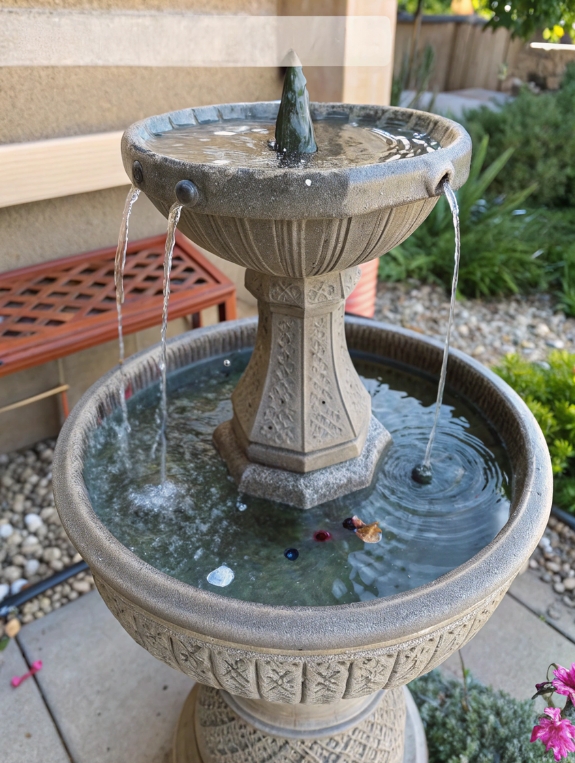
Water Depth and Basin Configuration
Hummingbird anatomy dictates specific water depth requirements for effective use. Ideal fountain designs incorporate shallow bathing areas ranging from 0.5 to 2 inches deep, accommodating the small stature of these birds whilst providing secure footing during drinking and bathing activities. Deeper sections should be avoided in primary bathing areas as they pose drowning risks for these lightweight creatures.
Basin shape and surface texture influence usability and safety. Gently sloping sides provide gradual depth transitions that allow hummingbirds to select optimal positions for different activities. Rough or textured surfaces offer superior grip for wet feet, reducing slip hazards during bathing sessions.
Flow Rate and Water Pressure
Gentle water movement proves most effective for hummingbird attraction compared to powerful jets or cascades that might intimidate these small birds. Optimal flow rates create subtle bubbling and trickling sounds without generating excessive splash or turbulence. Adjustable flow controls enable fine-tuning based on observed hummingbird responses and seasonal variations.
Consistent water pressure ensures reliable fountain operation and maintained attraction effectiveness. Intermittent or irregular flow patterns can confuse or discourage hummingbird visits, whilst steady operation builds familiarity and trust over time.
Materials and Construction Considerations
Natural materials such as stone, ceramic, or treated wood blend seamlessly with garden environments whilst providing durable, long-lasting fountain construction. These materials maintain stable water temperatures and resist degradation from constant moisture exposure. Avoid painted surfaces that might chip or flake, potentially contaminating water supplies.
Colour selection can influence hummingbird attraction levels. Neutral earth tones blend naturally with landscape settings, whilst strategic red or orange accents can provide additional visual appeal. However, avoid overwhelming colour schemes that might appear artificial or intimidating to cautious hummingbirds.
Strategic Fountain Placement for Maximum Appeal
Proximity to Existing Hummingbird Resources
Placing water features, like fountains, close to existing nectar sources makes them more effective for attracting hummingbirds. Aim to position these water features within 10-15 feet of spots where you already have flowers that draw hummingbirds.
This setup creates easy access to both water and food, encouraging hummingbirds to stay longer and visit more often. Arranging your garden this way supports natural hummingbird behaviour and helps you get the most out of your garden.
The relationship between nectar and water sources mirrors natural habitat arrangements where hummingbirds typically locate multiple resources within limited territories. Replicating these patterns through thoughtful fountain placement increases overall habitat attractiveness and usability.
Shelter and Safety Considerations
Protective vegetation surrounding fountain areas provides essential security that encourages relaxed hummingbird behaviour. Strategic placement near shrubs, trees, or tall plants offers quick escape routes should predators appear, whilst maintaining open access for drinking and bathing activities. This balance between security and accessibility proves crucial for sustained fountain use.
Predator deterrence through design and placement reduces risks that might discourage hummingbird visits. Elevating fountains slightly above ground level limits access for cats and other ground-based threats, whilst surrounding vegetation should be maintained to prevent ambush opportunities.
Sun and Shade Balance
Partial shade conditions provide optimal fountain environments that support extended hummingbird use throughout daily activity periods.
Excessive direct sunlight can create uncomfortable conditions and promote rapid evaporation, whilst deep shade might reduce the visual appeal of moving water. Strategic placement, achieving 4-6 hours of morning sun with afternoon shade, creates ideal conditions.
Seasonal sun patterns should be considered during fountain placement planning. Deciduous tree coverage can provide summer shade whilst allowing increased winter sunlight, supporting year-round fountain effectiveness in appropriate climates.
Types of Water Fountains That Attract Hummingbirds
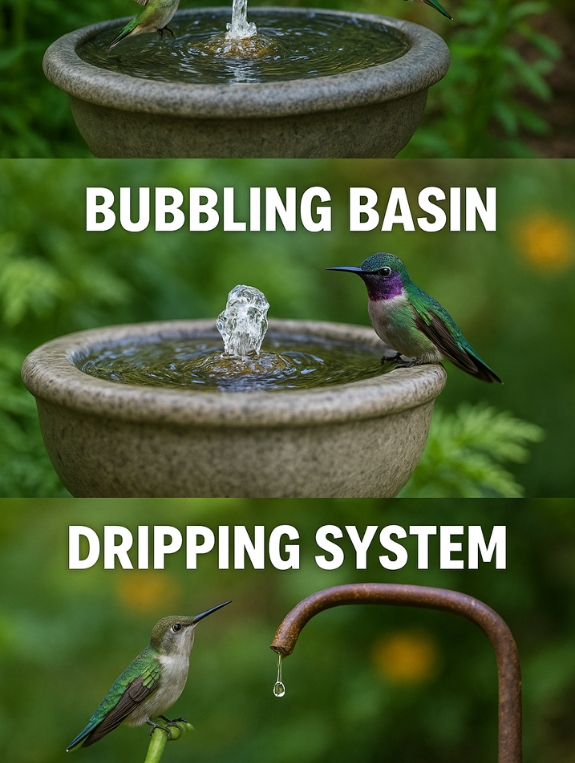
Solar-Powered Fountain Systems
Solar fountain pumps offer environmentally sustainable operation whilst eliminating electrical installation requirements. These systems provide quiet, efficient water circulation powered entirely by sunlight, making them ideal for remote garden locations or areas lacking electrical access. Modern solar technology ensures reliable operation even during partially cloudy conditions.
Battery backup systems in advanced solar fountains maintain operation during low-light periods, ensuring continuous water movement and attraction effectiveness. This reliability proves particularly important during migration seasons when consistent resources support travelling hummingbird populations.
Bubbling Basin Fountains
Bubbling basin designs create gentle water movement through bottom-mounted pumps that produce appealing sounds without creating excessive splash or intimidating water pressure. These fountains often incorporate best bubbling bird bath fountains features that specifically target bird attraction whilst maintaining aesthetic appeal.
The shallow, wide basin configuration typical of bubbling fountains provides ample space for multiple hummingbirds to use simultaneously, supporting social bathing behaviours observed in many species. The gentle bubbling action maintains water circulation whilst creating optimal bathing conditions.
Dripping and Misting Systems
Controlled dripping systems create distinctive sounds that prove particularly attractive to hummingbirds seeking fresh water sources. These systems can be incorporated into existing fountains or operated independently, providing targeted attraction through precise water delivery. Adjustable drip rates allow customisation based on seasonal requirements and observed preferences.
Misting components provide additional cooling benefits during hot weather whilst creating humidity zones that many hummingbird species find appealing. Fine mist spray can be particularly attractive during dry periods when natural humidity levels drop below optimal ranges.
Multi-Tiered Fountain Designs
Cascading water features with multiple levels provide varied flow rates and water depths to accommodate different hummingbird preferences and behaviours. Upper levels might feature gentle overflow action, whilst lower basins provide deeper soaking areas for thorough bathing sessions.
The complexity of multi-tiered systems creates diverse microhabitat opportunities within single installations, potentially attracting various hummingbird species with different water use preferences. This diversity proves particularly valuable in regions supporting multiple resident or migrating species.
The Connection Between Water Features and Hummingbird Behaviour
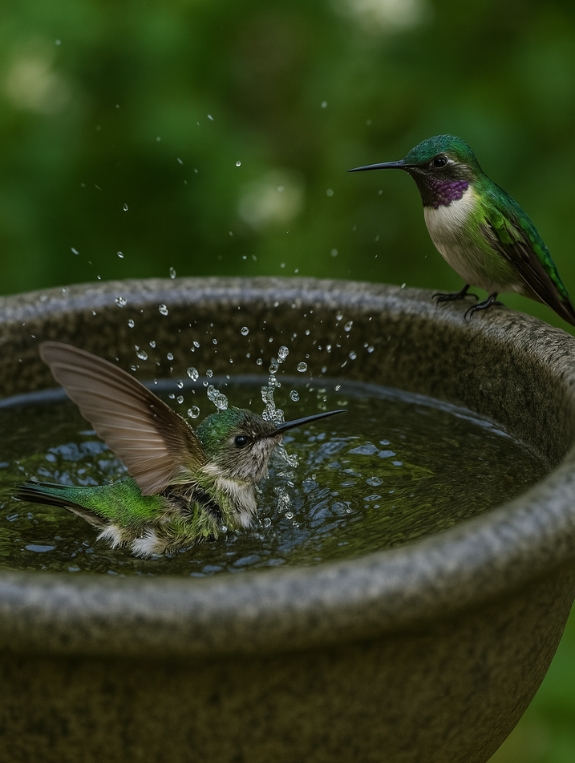
Bathing Rituals and Feather Maintenance
Hummingbird bathing behaviours represent complex sequences essential for feather maintenance and flight performance. These birds employ specific techniques, including shallow splashing, wing spreading, and careful preening, that require appropriate water depths and basin configurations. Understanding these behaviours enables fountain design optimisation for maximum usability.
Hummingbirds typically bathe every day when it’s warm and several times a week when it’s cooler. Bathing is important for hummingbirds as it helps them stay in good condition and maintain their flying abilities.
Social Interactions Around Water Sources
Territorial behaviours around water sources can influence fountain effectiveness and design requirements. Dominant hummingbirds might monopolise preferred fountains, necessitating multiple water sources to accommodate hierarchical social structures. Strategic placement of several smaller fountains often proves more effective than single large installations.
Peaceful coexistence at water sources occurs more frequently than at nectar feeders, as water provides less concentrated energy rewards that reduce competitive pressure. This tendency supports community water access that benefits multiple individuals and species simultaneously.
Seasonal Water Usage Patterns
Migration periods create increased water demands as travelling hummingbirds seek reliable resources for recovery and preparation. Fountain operation during spring and autumn migration windows provides critical support for these energy-intensive journeys. Consistent water availability during these periods can establish your garden as a recognised stopover site.
Breeding season requirements include increased water needs for parent birds, maintaining high activity levels whilst caring for young. Additionally, juvenile hummingbirds learning independence benefit from accessible water sources that support their development and survival rates.
Maintenance Requirements for Hummingbird-Friendly Fountains
Water Quality Management
Regular water changes prevent the accumulation of bacteria, algae, and other contaminants that could harm visiting hummingbirds. Complete water replacement every 3-5 days during active use periods ensures optimal water quality, whilst weekly changes might suffice during low-activity seasons. Fresh, clean water remains the single most important factor in maintaining hummingbird health and continued fountain use.
Cleaning protocols should eliminate soap residues, chemical treatments, or other substances that might prove toxic to hummingbirds. Simple scrubbing with clean brushes and thorough rinsing provides adequate sanitation without introducing harmful compounds. Natural cleaning methods using vinegar solutions can address mineral buildup whilst maintaining bird-safe conditions.
Pump and Equipment Care
Pump maintenance ensures reliable water circulation, essential for maintaining attraction effectiveness. Regular inspection and cleaning of pump intakes prevents clogs from leaves, algae, or debris that could disrupt operation.
Seasonal pump care, including winterisation in freezing climates, protects equipment whilst ensuring rapid spring restart capability.
Filter systems require periodic attention to maintain optimal water quality and pump performance. Regular cleaning or replacement of filters prevents restriction of water flow whilst removing contaminants that could affect fountain appeal or hummingbird health.
Seasonal Considerations
Winter operation in temperate climates requires special consideration for fountain management. Heating elements can maintain liquid water during freezing periods, providing critical resources when natural sources become unavailable. However, energy costs and equipment reliability must be balanced against conservation benefits.
Summer maintenance intensifies due to increased evaporation rates and potential algae growth in warm conditions. More frequent water changes and enhanced cleaning schedules become necessary to maintain optimal conditions during peak hummingbird activity periods.
Complementing Fountains with Other Garden Features
Native Plant Integration
Native flowering plants provide natural nectar sources that complement fountain water resources, creating a comprehensive hummingbird habitat within garden settings. Native plants that attract more hummingbirds than sugar water offer superior long-term sustainability compared to artificial feeders, whilst supporting broader ecosystem health.
Diverse bloom schedules ensure continuous nectar availability throughout hummingbird activity seasons, reducing dependency on artificial supplements whilst maintaining garden appeal. Strategic plant selection can provide sequential flowering that supports resident populations and migrating species across extended periods.
Shelter and Nesting Support
Protective vegetation surrounding fountain areas creates microhabitat complexity that supports extended hummingbird residency beyond simple resource provision. Dense shrubs, climbing vines, and small trees provide nesting sites, perching opportunities, and predator protection that transform gardens into comprehensive habitat units.
Nesting material provision through careful plant selection and garden management supports breeding hummingbirds that might establish territories around reliable water sources. Spider webs, soft plant fibres, and small lichens naturally occurring in diverse gardens provide essential construction materials for these tiny architects.
Multiple Water Source Strategy
Distributed water features throughout larger gardens accommodate territorial behaviours whilst ensuring water access for all visiting hummingbirds regardless of social hierarchies. Multiple smaller fountains often prove more effective than single large installations, providing options for different species and individual preferences.
Varied fountain types can target different aspects of hummingbird water use, with some optimised for drinking, others for bathing, and additional features for cooling or humidity provision. This functional diversity maximises habitat appeal whilst supporting comprehensive behavioural requirements.
Troubleshooting Common Fountain Issues
Low Hummingbird Visitation
Inadequate fountain placement represents the most common cause of poor hummingbird attraction. Fountains positioned too far from nectar sources, lacking adequate shelter, or situated in inappropriate sun/shade conditions fail to meet basic habitat requirements. Systematic evaluation of placement factors often reveals simple solutions for improving effectiveness.
Water quality problems, including stagnation, contamination, or chemical residues, can discourage hummingbird use despite optimal placement and design. Regular maintenance schedules and attention to water freshness typically resolve these issues, whilst ongoing monitoring prevents recurrence.
Equipment Malfunctions
Pump failures disrupt the critical water movement that provides primary attraction for hummingbirds. Regular pump maintenance, appropriate winter storage, and prompt repair or replacement of failed components maintain consistent fountain operation essential for sustained hummingbird visits.
Flow rate irregularities can result from partially clogged pumps, restricted tubing, or inappropriate system sizing. Systematic troubleshooting of water circulation components typically identifies and resolves these problems, restoring optimal fountain performance.
Competing Wildlife Issues
Larger bird species might monopolise fountain access, discouraging hummingbird use through intimidation or simple space occupation. Multiple-fountain strategy and careful design selection can provide hummingbird-specific access whilst accommodating diverse garden wildlife needs.
Predator presence, including cats, snakes, or aggressive bird species around fountain areas, can eliminate hummingbird visitation despite optimal water features. Habitat modification to reduce predator opportunities whilst maintaining hummingbird access often resolves these conflicts.
Seasonal Strategies for Year-Round Effectiveness
Spring Activation and Migration Support
Early season fountain preparation provides critical resources for spring migrants arriving before natural water sources become readily available. Prompt activation following winter shutdowns ensures immediate resource availability during peak migration periods when reliable water sources prove most valuable.
Maintenance intensification during spring startup addresses winter-related issues whilst ensuring optimal fountain condition for increased seasonal activity. Fresh water, cleaned components, and verified operation support both resident populations and travelling hummingbirds establishing or renewing territorial claims.
Summer Peak Operations
Enhanced maintenance schedules during summer accommodate increased usage whilst managing elevated evaporation rates and potential algae growth. Daily water monitoring ensures consistent quality and availability during peak activity periods when hummingbird populations reach maximum levels.
Cooling strategies, including increased circulation, strategic shading, and misting components, provide additional relief during extreme heat periods that stress both resident and visiting hummingbird populations. These enhancements extend usable hours and improve overall habitat quality.
Autumn Migration Preparation
Consistent operation during autumn migration windows supports southbound travellers requiring reliable resources for energy restoration and journey preparation. Maintaining fountain operation during this critical period can significantly impact survival rates for birds facing extensive travel challenges.
Enhanced cleaning protocols address increased usage whilst preparing systems for potential winter shutdowns in appropriate climates. Resource reliability during migration periods establishes gardens as recognised stopover sites that might attract increased visitation in subsequent seasons.
Winter Considerations
Heating strategies in temperate climates can maintain liquid water during freezing periods, providing critical resources when natural sources become unavailable. However, energy costs and equipment reliability must be balanced against conservation benefits and practical limitations.
Alternative approaches, such as heated bird baths or seasonal fountain replacement, may be more practical than maintaining full fountain operation during extreme weather. Flexible strategies adapted to local climate conditions optimise resource provision whilst managing practical constraints.
Maximising Your Success with Hummingbird Water Features
Patience and Persistence
Hummingbirds take several weeks to discover new water features like fountains. During this time, they adjust their behaviour and learn where these features fit into their territory.
Understanding how long it takes hummingbirds to find a feeder helps us understand similar timelines for discovering water features. It’s important to keep these features consistently running during this establishment period.
Gradual acceptance typically proceeds through stages including initial investigation, tentative use, and eventual integration into daily routines. Sustained fountain operation during these developmental phases proves essential for achieving long-term success with hummingbird attraction.
Documentation and Observation
Usage monitoring enables optimisation of fountain features and placement based on observed hummingbird behaviours and preferences. Regular observation reveals patterns of use, species preferences, and seasonal variations that inform management decisions and potential improvements.
Photographic documentation provides valuable records of hummingbird species, behavioural patterns, and fountain effectiveness that support long-term garden development and habitat enhancement strategies. These records also contribute to citizen science efforts supporting hummingbird conservation research.
Community Integration
Neighbourhood coordination of hummingbird-friendly features, including fountains, feeders, and native plantings, creates expanded habitat networks that support increased populations and breeding success. Collaborative approaches prove more effective than isolated efforts, particularly for supporting territorial species requiring adequate space and resources.
Educational outreach sharing successful fountain strategies and hummingbird attraction techniques contributes to broader conservation efforts whilst potentially increasing local hummingbird populations through enhanced habitat availability.
Final Thoughts
Water fountains represent powerful tools for hummingbird attraction that complement traditional feeding strategies whilst addressing essential physiological requirements often overlooked in basic garden planning.
The multi-sensory appeal of moving water, combined with critical hydration and bathing opportunities, creates irresistible habitat features that significantly enhance garden attractiveness to these remarkable birds.
Success with hummingbird fountains requires understanding the complex interplay between fountain design, strategic placement, maintenance requirements, and broader habitat considerations.
By implementing comprehensive approaches that address all aspects of hummingbird ecology, gardeners can create a sustainable habitat that supports both resident populations and migrating species whilst providing endless opportunities for wildlife observation and appreciation.
The investment in quality fountain systems and consistent maintenance pays dividends through increased hummingbird visitation, extended garden seasons, and enhanced wildlife diversity.
These features transform ordinary gardens into dynamic ecosystems that provide year-round interest whilst contributing meaningfully to hummingbird conservation efforts.
FAQ
Q: How quickly will hummingbirds discover a new water fountain?
A: Discovery typically occurs within 1-3 weeks of installation, though this varies based on local hummingbird populations, placement quality, and existing garden resources. Consistent operation and strategic placement near nectar sources accelerate discovery rates.
Q: What water depth works best for hummingbird fountains?
A: Optimal depths range from 0.5-2 inches, providing secure bathing areas whilst preventing drowning risks. Multiple depth zones within single fountains accommodate different activities and individual preferences.
Q: Should I add anything to fountain water to attract hummingbirds?
A: Clean, fresh water requires no additives for hummingbird attraction. Avoid chemicals, soaps, or supplements that might harm these sensitive birds. Regular water changes maintain optimal quality naturally.
Q: Can fountains operate during winter in cold climates?
A: Heated fountain systems can provide critical winter water sources, though energy costs and equipment reliability must be considered. Alternative approaches might include seasonal heated bird baths or winter fountain storage.
Q: How often should fountain water be changed?
A: Complete water changes every 3-5 days during active periods maintain optimal quality, with weekly changes adequate during slower seasons. Hot weather and heavy usage require more frequent attention.
Q: Do hummingbirds prefer specific fountain sounds?
A: Gentle bubbling and trickling sounds prove most attractive, whilst avoiding powerful jets or loud splashing that might intimidate these small birds. Adjustable flow controls enable optimisation based on observed preferences.
Q: Where should fountains be positioned relative to hummingbird feeders?
A: Placement within 10-15 feet of established nectar sources creates convenient resource clusters that encourage extended visits. This proximity supports natural territorial behaviours whilst maximising garden efficiency.
Q: Can multiple hummingbirds use fountains simultaneously?
A: Yes, water sources experience less territorial competition than feeders, often accommodating multiple individuals peacefully. Larger basins and multiple fountain installations further reduce conflicts.
Q: What fountain materials work best for hummingbird attraction?
A: Natural materials, including stone, ceramic, or treated wood, provide durability whilst blending with garden environments. Avoid painted surfaces or materials that might contaminate water supplies.
Q: How do I maintain fountain pumps for reliable operation?
A: Regular cleaning of pump intakes, seasonal maintenance including winterisation, and prompt replacement of worn components ensure consistent operation essential for sustained hummingbird attraction.
